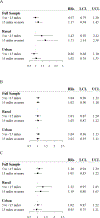Evaluating the urban-rural paradox: The complicated relationship between distance and the receipt of guideline-concordant care among cervical cancer patients
- PMID: 30442384
- PMCID: PMC6321781
- DOI: 10.1016/j.ygyno.2018.11.010
Evaluating the urban-rural paradox: The complicated relationship between distance and the receipt of guideline-concordant care among cervical cancer patients
Abstract
Objective: Urban-rural health disparities are often attributed to the longer distances rural patients travel to receive care. However, a recent study suggests that distance to care may affect urban and rural cancer patients differentially. We examined whether this urban-rural paradox exists among patients with cervical cancer.
Methods: We identified individuals diagnosed with cervical cancer from 2004 to 2013 using a statewide cancer registry linked to multi-payer, insurance claims. Our primary outcome was receipt of guideline-concordant care: surgery for stages IA1-IB1; external beam radiation therapy (EBRT), concomitant chemotherapy, and brachytherapy for stages IB2-IVA. We estimated risk ratios (RR) using modified Poisson regressions, stratified by urban/rural location, to examine the association between distance to nearest facility and receipt of treatment.
Results: 62% of 999 cervical cancer patients received guideline-concordant care. The association between distance and receipt of care differed by type of treatment. In urban areas, cancer patients who lived ≥15 miles from the nearest surgical facility were less likely to receive primary surgical management compared to those <5 miles from the nearest surgical facility (RR: 0.77, 95% CI: 0.60-0.98). In rural areas, patients living ≥15 miles from the nearest brachytherapy facility were more likely to receive treatment compared to those <5 miles from the nearest brachytherapy facility (RR: 1.71, 95% CI: 1.14-2.58). Distance was not associated with the receipt of chemotherapy or EBRT.
Conclusions: Among cervical cancer patients, there is evidence supporting the urban-rural paradox, i.e., geographic distance to cancer care facilities is not consistently associated with treatment receipt in expected or consistent ways. Healthcare systems must consider the diverse and differential barriers encountered by urban and rural residents to improve access to high quality cancer care.
Keywords: Cervical cancer patients; Disparities; Distance to care; Guideline-concordant care; Urban/rural.
Copyright © 2018 Elsevier Inc. All rights reserved.
Conflict of interest statement
Conflicts of Interest
The authors have no conflicts of interest to disclose.
Figures


Similar articles
-
Examining Urban and Rural Differences in How Distance to Care Influences the Initiation and Completion of Treatment among Insured Cervical Cancer Patients.Cancer Epidemiol Biomarkers Prev. 2019 May;28(5):882-889. doi: 10.1158/1055-9965.EPI-18-0945. Epub 2019 Feb 7. Cancer Epidemiol Biomarkers Prev. 2019. PMID: 30733307 Free PMC article.
-
Effects of distance to care and rural or urban residence on receipt of radiation therapy among North Carolina Medicare enrollees with breast cancer.N C Med J. 2014 Jul-Aug;75(4):239-46. doi: 10.18043/ncm.75.4.239. N C Med J. 2014. PMID: 25046086
-
Geographic disparities in residential proximity to colorectal and cervical cancer care providers.Cancer. 2020 Mar 1;126(5):1068-1076. doi: 10.1002/cncr.32594. Epub 2019 Nov 8. Cancer. 2020. PMID: 31702829
-
Evidence Brief: Effects of Small Hospital Closure on Patient Health Outcomes [Internet].Washington (DC): Department of Veterans Affairs (US); 2013 Jun. Washington (DC): Department of Veterans Affairs (US); 2013 Jun. PMID: 27606393 Free Books & Documents. Review.
-
Is long travel distance a barrier to surgical cancer care in the United States? A systematic review.Am J Surg. 2021 Aug;222(2):305-310. doi: 10.1016/j.amjsurg.2020.12.005. Epub 2020 Dec 7. Am J Surg. 2021. PMID: 33309254
Cited by
-
The impact of patient travel time on disparities in treatment for early stage lung cancer in California.PLoS One. 2022 Oct 5;17(10):e0272076. doi: 10.1371/journal.pone.0272076. eCollection 2022. PLoS One. 2022. PMID: 36197902 Free PMC article.
-
Hospital Designations and Their Impact on Guideline-Concordant Care and Survival in Pancreatic Cancer. Do They Matter?Ann Surg Oncol. 2023 Jul;30(7):4377-4387. doi: 10.1245/s10434-023-13308-7. Epub 2023 Mar 25. Ann Surg Oncol. 2023. PMID: 36964844
-
Treatment of cervical cancer: overcoming challenges in access to brachytherapy.Expert Rev Anticancer Ther. 2022 Apr;22(4):353-359. doi: 10.1080/14737140.2022.2047936. Epub 2022 Mar 20. Expert Rev Anticancer Ther. 2022. PMID: 35227148 Free PMC article. Review.
-
Socioeconomic inequality and omission of adjuvant radiation therapy in high-risk, early-stage endometrial cancer.Gynecol Oncol. 2021 May;161(2):463-469. doi: 10.1016/j.ygyno.2021.01.041. Epub 2021 Feb 15. Gynecol Oncol. 2021. PMID: 33597092 Free PMC article.
-
The Role of Rurality, Travel Time, and Neighborhood Socioeconomics on Patterns of Adjuvant Therapy Receipt among Patients with Endometrial Cancer.Cancer Epidemiol Biomarkers Prev. 2025 Aug 1;34(8):1277-1285. doi: 10.1158/1055-9965.EPI-24-1201. Cancer Epidemiol Biomarkers Prev. 2025. PMID: 40459535 Free PMC article.
References
-
- Mayadev J, Klapheke A, Yashar C, et al. Underutilization of brachytherapy and disparities in survival for patients with cervical cancer in California. Gynecol Oncol (in press) - PubMed
-
- Rauh-Hain JA, Melamed A, Schaps D, et al. Racial and ethnic disparities over time in the treatment and mortality of women with gynecological malignancies. Gynecol Oncol 2018;149:4–11. - PubMed
-
- Singh GK, Miller BA, Hankey BF, et al. Persistent area socioeconomic disparities in US incidence of cervical cancer, mortality, stage, and survival, 1975–2000. Cancer 2004;101:1051–1057. - PubMed

